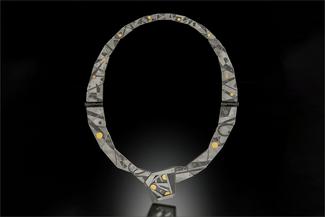Attach, Connect, Link
This demo-focused virtual workshop will explore exciting and alternate ways to attach and connect small components together. The emphasis of the class is to create a chain of metal elements that flow and function together, and transition into a linkage system. The finished designs can be for any use: a stand-alone necklace, a chain for a pendant, a bracelet, or a clever jewelry object of choice. Participants will learn how to cut metal components by punching and hand sawing metal. An exploration of cold connecting will be covered. Students will be introduced to a variety of clasping devices that will add purpose and personality to a finished jewelry piece. Project materials include: sheet metal, tubing, wire, chain, and a variety of prefabricated components. Participants are encouraged to come with an imaginative, experimental approach to jewelry making.
Meet the instructor

"When designing jewelry, I incorporate geometric influences of human and naturally made objects. These combined visual patterns and shapes help stimulate the creative process. The end results are graphic representations of sweeping curves, upward perspectives and overlapping alignments in detail. The goal is to establish images in miniature that go beyond the mundane and predictable which establishes a unique vision.
Each of my creations develops from graphic drawings on paper that transform to finished three-dimensional constructions. I hand cut metal components of sheet, tubing and wire to meet the demands of an intended design. Occasionally I implement technology by having some components laser cut. Little holes are arranged on the multiple parts with a drill press. Small wires are then fitted through. Measured pieces of tubing are beaded on to serve as spacers. This becomes a repeated layering activity and finished by having the wire ends tapped (rivets) with a hammer and anvil. The completed piece will incorporate my aesthetic concerns combined with the engineering elements that reflect my visual style.
The primary material I use is titanium (Ti). This gray-toned metal is ideal for jewelry design. It is light in weight, strong, hypoallergenic and non-corrosive. With many designs, I also combine gold and/or silver metals to highlight and add contrast to the finished piece.
The seeds for jewelry design began at an early age and took form in college. When I was five I began making plastic models. I focused on science fiction related themes and subjects of World War Two. With continued years of interest, I developed unique skills for making miniature objects. In college at The University of Iowa I became interested in studio art gravitating to metalsmithing and jewelry design. By the time I graduated in 1989 the years of making models and the education in metalworking provided opportunities for professional success.
I live in Kutztown Pennsylvania with my wife Amy and daughter Annabel. My wife is a professor in Art Education at Kutztown University. I work from home as a solo artist and travel the country exhibiting my jewelry and conducting workshops. As a family we enjoy cooking and entertaining. To keep in shape, I train regularly in Shorin-ryu karate. I stay involved in my daughter’s creative problem-solving program, (Odyssey of the Mind) as a coach and board member. When time provides I take pleasure in keeping track of my beloved Iowa Hawkeye football team." - E. Douglas Wunder
Materials & Tools
A comprehensive list of supplies that will be used for course demonstrations and objectives can be found by clicking HERE. Student participation during or in-between class sessions is welcomed but not required - observers are welcome.


